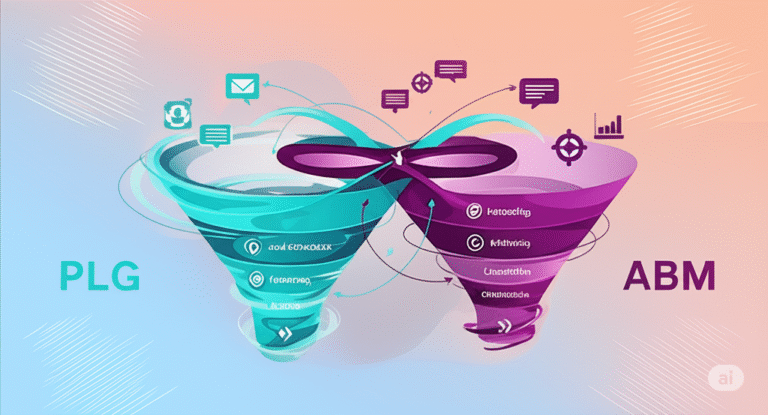AI-Powered Account Selection: Identifying Enterprise Accounts with Machine-Learning
How to point Sales and Marketing at the right target accounts, without getting bogged in data
Most teams chase too many look-alike accounts. A lightweight, explainable model trained on stable company attributes, and later enriched with behavioral signals, can surface the top 20% of accounts that truly give your business it’s best results. Use Pareto’s principle to your advantage: Route those fast, personalize your plays, and measure lift in win-rate, speed-to-meeting, and ACV.
From Guessing to Clarity: How Smarter Account Scoring Transforms Your Pipeline
Your pipeline is full, but progress is slow. Then your team tests a simple model that ranks accounts by ICP tier and “interest temperature.” Within a month, reps start their weeks with a short, clear list of targets. Meetings book faster. Deals move with less friction. And the GTM team finally sees a pipeline that looks predictable.
Consider ZoomInfo’s experience. By layering buyer-intent data with their existing first-party signals, they were able to identify in-market accounts long before competitors reached them. Sales reps didn’t just get more leads. They got smarter ones. Conversion rates climbed, cost per lead dropped, and suddenly their growth engine was working with precision instead of guesswork (ZoomInfo, 2024). That’s the power of moving from gut feel to data-driven lead scoring.
Firsthand Observations from the Field
In my career leading demand generation and growth strategies at B2B SaaS companies like Auth0, Vanta, and ServiceTitan, I’ve experienced the challenges of account selection up close. I’ve seen firsthand how bloated target lists confuse sales teams and waste budget, and how the absence of clear scoring slows everything from trial conversions to enterprise deal cycles.
At Vanta, for example, we used data-driven prioritization to identify and focus on accounts showing the strongest compliance needs, which allowed us to concentrate pipeline efforts where the highest-value deals were most likely to close. At ServiceTitan, improving trial-to-paid conversions meant getting more precise about which accounts and industries would be most likely to purchase and less likely to churn. These experiences taught me that when data-driven scoring is paired with sales alignment, revenue outcomes improve dramatically. As teams are being
ed with information, AI-powered account selection isn’t optional. It’s the next evolution for the GTM landscape.
Why Account Selection Matters
Guessing is expensive. Teams waste hours on low-fit leads, lengthening cycles and missing quarters. When sales and marketing chase the wrong logos, the result is bloated lists, wasted ad dollars, and exhausted SDRs. Every misstep compounds, draining both budget and morale.
But the clues are out there. Headcount growth, job postings, tech stack changes, and new executive hires all signal opportunity. AI makes it possible to surface these signals at scale and translate them into reliable lead scores. Instead of drowning in spreadsheets, reps spend their time where it counts—on accounts with the highest likelihood of turning into revenue.
What Account Tiering Can Look Like
Strong account tiering starts with the basics. Fit accounts align with your ICP criteria: employee count, revenue band, industry, region, and preferred software. Beyond that, the presence of structured buying committees reveals whether an organization can truly move a deal forward: users, champions, budget owners, IT/security, legal, and procurement. A practical way to align expectations is to segment accounts into Corporate (50–499 employees), Enterprise (500–9,999 employees), and Strategic (10,000+ employees) tiers based on your industry and ICP.
Readiness signals elevate this further. Hiring spurts, executive turnover, vendor replacement chatter, or international expansion can all push an account into a higher score tier. You can also watch for spikes in relevant searches, review-site visits, or direct website engagement.
The Data You Actually Need
To build an effective AI-powered account selection model, you need a mix of data types that balance stability with real buying intent. Stable data forms the foundation, while behavioral signals help with showing immediacy in lead scoring. Case studies show that layering intent signals into targeting campaigns has lifted win rates significantly—for example, Reachdesk achieved a 35% win rate using intent data (6sense, 2023).
Start with firmographics and technographics as your baseline, then add intent, telemetry, and CRM outcomes for context and proof of traction. The more layers you include, the more accurate your lead scoring will become. Think of it as building a house: firmographics and technographics are your walls, while intent and telemetry act as the windows and doors that bring the structure to life.
- Firmographic data – size, industry, revenue bands, geo. Baseline fit.
- Technographic data – current tools, cloud provider, identity stack. Integration fit and maturity.
- Intent data – search interest, review-site signals, relevant job posts. Active projects.
- Product telemetry – seat growth, feature use, admin actions. Bottom-up traction.
- Historical CRM outcomes – stages, win/loss, reasons. What “good” looked like.
Data quality checklist: freshness SLAs, dedupe rules, null handling, and shared key records (account_id, domain). Protect personally identifiable information (PII) with role-based access and masking.
Build a Simple, Trustworthy Model
Simplicity builds trust. Start with explainable selection prompts, trained on firmographics, technographics, and historical outcomes. Avoid over-weighting short-term usage spikes, which can skew results. Instead, focus on stable attributes that clearly distinguish past wins from losses.
Label historical deals as Corporate or Enterprise to provide reliable training signals. Optimize for precision rather than recall. It’s better to have a lean, accurate list than a bloated one that erodes confidence. Once the model proves itself, enrich it with behavioral signal prompts like website visits, whitepaper views, product documentation viewed, or in-product actions. Over time, build a rolling 3–6-month “readiness temperature” score using AI agents to reflect recent trends without losing historical context.
Turn Lead Scoring into Action
Scores only matter if they drive action. A well-structured scoring system should map directly to GTM workflows. High scores should trigger immediate ABM and sales routing, while mid-tier scores stay in automated nurture until they show stronger buying intent. Low scores remain in self-serve or light-touch motions, with monitoring in place for sudden upgrades.
Execution speed is crucial. If it takes more than 24 hours for a high-scoring account to reach a rep’s desk, the advantage is lost. Clear playbooks for each tier ensure consistency and dependability: executive intros for top accounts, automated sequences for mid-tier, and educational campaigns for lower scores. Transparency also matters. Sales reps need to see the top reasons behind every score to build trust in the system.
What to Measure (Executive View)
Leaders can’t manage what they don’t measure. That’s why both business outcomes and model performance need to be tracked in parallel. On the business side, look for tangible improvements: higher win rates on high-score accounts, more meetings per rep hour, larger ACV, faster time-to-meeting, and healthier pipeline coverage.
On the model side, focus on consistency and accuracy. Monitor hit rates on flagged accounts, overall coverage of good opportunities, total addressable market being evaluated, and precision of the top-tier picks. Compare results against your old targeting methods to demonstrate clear lift. Regular reviews, weekly GTM snapshots, and monthly “model health” assessments, ensure that lead scoring remains an improving, trustworthy system. Research by McKinsey has shown that generative AI can drive significant revenue growth and productivity in B2B sales when applied to targeting and prioritization (McKinsey, 2025; McKinsey, 2024).
Pitfalls and Fixes
Even the best-designed models can falter without guardrails. One common pitfall is overfitting to recent wins, which creates a distorted picture of what success looks like. The fix is simple: keep at least a year of history in your training data and use time-based validation to smooth out anomalies.
Other risks include cold-start accounts without historical data, resistance from sales teams who distrust “black box” scoring, and operational clashes like territory disputes. To avoid these, establish fallback rules, provide reason codes for every score, and align with RevOps before rollout. Model drift is another hidden trap; monitor feature distributions, set alerts, and retrain regularly to stay ahead.
4-Step Launch Plan
Rolling out AI-powered account selection doesn’t have to be overwhelming. By breaking the process into four clear steps, teams can move from messy spreadsheets to trustworthy scoring in weeks, not months. Start with the data you already have, build alignment with Sales, and prove early wins through a pilot program.
Once the basics are in place, scale gradually. Add behavioral signals, automate routing, and expand scoring across the full GTM motion. This phased approach prevents overwhelm and ensures that adoption sticks. Done right, the 4-step plan creates a repeatable playbook for future iterations.
- Audit data sources – catalog firmographic, technographic, intent, product telemetry, and CRM outcomes; note freshness and gaps.
- Define labels with Sales & RevOps – agree on Enterprise vs. Corporate and label past deals together.
- Pilot and compare – build a simple model on stable attributes; test in one region/industry and compare against current targeting and win-rates.
- Iterate and roll out – once you see lift, add behavioral signals, automate routing/alerts, and roll scoring out to the full team.
Supporting documentation to create: a data dictionary, label rules, scoring guide, two playbook templates, and a dashboard spec.
Conclusion & Next Steps
AI doesn’t replace human judgment, it sharpens it. By starting with stable, explainable signals, revenue leaders can build trust while proving tangible lift. From there, layering in behavioral data and automating workflows creates a system that scales with your business. Industry frameworks such as Gartner’s Account-Based Everything model show that coordinated targeting across Sales, Marketing, and Success consistently outperforms generic outreach (Gartner, 2023).
In just a few weeks, your GTM motion can keep its speed, your ABM team can hunt with sharper aim, and your forecasts can finally feel more trustworthy. The key is to start simple, show results fast, and keep iterating. That’s how AI-powered account selection turns into a durable growth advantage.
References
- Reachdesk achieves 35% win rate with 6sense intent data, 6sense, 2023. URL: https://6sense.com/customer-stories/reachdesk-achieves-35-win-rate-with-6sense-intent-data/
- ZoomInfo improves conversion and lowers CPL with G2 Buyer Intent, 2024. URL: https://sell.g2.com/case-studies/zoominfo-buyer-intent-conversion-rate
- McKinsey, Unlocking Profitable B2B Growth Through Gen AI, 2025. URL: https://www.mckinsey.com/capabilities/growth-marketing-and-sales/our-insights/unlocking-profitable-b2b-growth-through-gen-ai
- McKinsey, Harnessing Generative AI for B2B Sales, 2024. URL: https://www.mckinsey.com/capabilities/growth-marketing-and-sales/our-insights/harnessing-generative-ai-for-b2b-sales
- Gartner, The Account-Based Everything Framework, 2023. URL: https://www.gartner.com/en/insights/sales/account-based-everything
*This article was created using the support of AI (ChatGPT 5 & Gemini 2.5 Flash)



